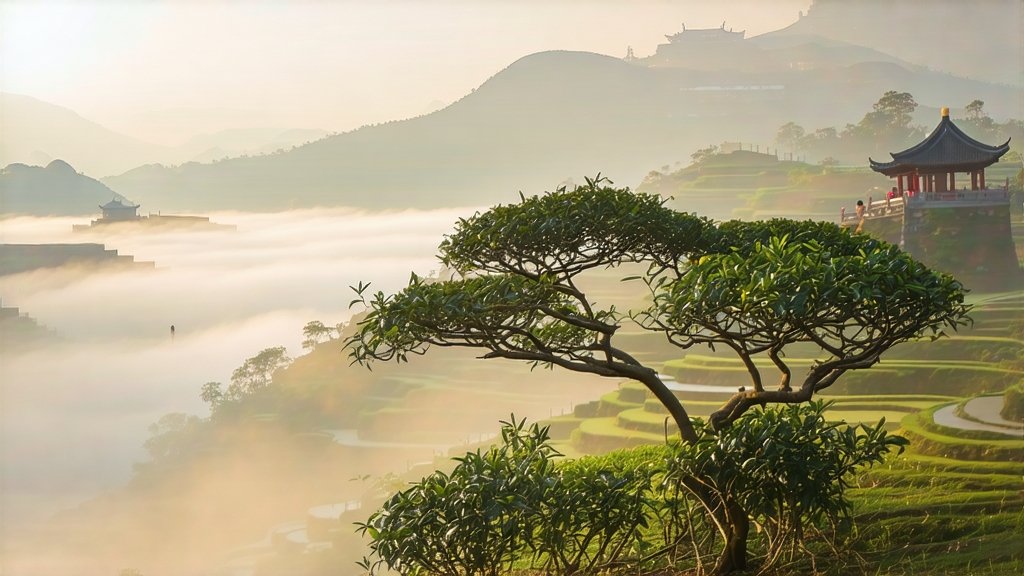
If oolong is the jazz of Chinese tea—improvisational, layered, forever balancing between green freshness and black depth—then Phoenix Dancong is the saxophone solo that makes the whole room fall silent. Grown on the steep, mineral-rich slopes of Phoenix Mountain (Fenghuang Shan) in northern Guangdong, this single-trunk, old-arbor cultivar family has seduced emperors, scholars and now third-wave tea lovers with its uncanny ability to taste like flowers none of us have ever tasted before. Walk with me from Song-dynasty legends to the modern gongfu counter, and discover why a tiny leaf can smell of fresh ginger lilies, roasted almond, or a just-peeled mandarin.
-
A tree that remembers the Song dynasty
Local chronicles claim that Song-era refugees, fleeing Mongol cavalry, carried tea seeds from the Wuyi cliffs into Guangdong. On Phoenix Mountain they found a micro-climate wrapped in fog until noon, then scorched by subtropical sun—perfect for forcing a tea bush to produce aromatic oils in self-defence. The newcomers noticed that certain individual trees developed unique, stable fragrances; they marked them with charcoal, propagated them by seed, and began the practice of “single bush” (dancong) harvesting. By the Ming, tribute lists record “Phoenix Song Zhong” arriving in Beijing, wrapped in silk and escorted by armed guards. Today, 700-year-old mother trees still stand on Wudong peak, their gnarled trunks as thick as a wrestler’s thigh, protected by barbed wire and blessed with incense each spring. -
The cultivar alphabet: from orchid to yulan
Unlike the rock oolongs of Wuyi, which are grouped by the cliff garden they grow on, Phoenix Dancong is classified by aroma type. More than 80 “fragrance profiles” have been documented, but ten dominate the market:
• Orchid Fragrance (Lan Xiang) – the classic, soft and powdery
• Ginger Lily (Yulan Xiang) – heady, creamy, with a citrus lift
• Almond Fragrance (Xing Ren) – marzipan and toasted rice
• Honey Orchid (Mi Lan Xiang) – lychee jam and wet granite
• Yellow Gardenia (Huang Zhi) – bright, tannic, with a snap of green apple
• Night-Blooming Jasmine (Mo Li) – seductive, almost boozy
• Cinnamon (Rou Gui) – sweet wood and baking spice
• Gardenia & Bitter Orange (Zhi Hui) – palate-cleansing, cocktail-bitter finish
• Sesame & Licorice (Zhi Ma) – dark-roast, cocoa nib undertones
• Old-Tree Charcoal (Lao Cong) – resinous pine smoke, dried longan, wet slate
Each profile is tied to a specific village micro-terroir: higher elevations (600-1,400 m) give tighter leaf, higher salinity in the soil amplifies sweetness, while cooler nights lock in volatile esters. A tea labeled “Wudong” must come from above 800 m; below that, the same cultivar may sell for one-tenth the price yet still dazzle neophytes.
- Craft: the four-day odyssey from leaf to twist
Phoenix Dancong is one of the last Chinese teas still processed entirely by hand in 8- to 15-kilogram batches, allowing the teamaster to “listen” to the leaf.
Step 1: Plucking – Only the standard “fish-leaf” set (two mature leaves and a half-open bud) is picked between 9 a.m. and 2 p.m., when surface moisture has burned off but turgor pressure is high. Experienced pluckers snap, never cut, to keep the stem node intact; that node is where the fragrance concentrates.
Step 2: Sun Wither – Leaves are laid 3 cm thick on bamboo sieves under 28 °C sun for 20–30 minutes, turned every ten. The goal is to lose 8 % moisture and trigger grassy-to-floral enzymatic conversion.
Step 3: Shade Wither – Sieves move onto racks in a ventilated loft for 4–6 hours. Leaf temperature drops, cell membranes weaken, and a faint pineapple note appears.
Step 4: Oxidation Roulette – Here lies the